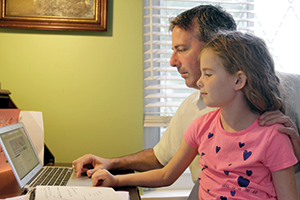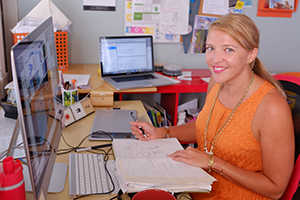Juggling it all
Employees today want a work-life balance
Beth Cooper //September 29, 2015//
When Amy Cole leaves her office each day, she visualizes walking into her house empty handed — her cellphone and computer left behind on her desk.
That exercise, says Cole, the director of partner advancement at the Southern Virginia Higher Education Center in South Boston, forces her to disconnect from work and focus on her home life. “I make myself put a line between work and home,” says Cole, a wife and mother of two teenagers. “Over the years, I’ve learned to place importance on trying to make sure I balance a healthy lifestyle and get over the mindset that ‘busyness’ is a good thing. Our culture tells us the busier you are the better you are. That, in my mind, is not a good philosophy.”
Her attitude stems from challenges she faced in the past juggling her career, including a stint as interim executive director of the SVHEC, with single parenthood. “I became a single mom when my daughter was 3 months old,” Cole says. “It’s very challenging for a single-income parent to manage a household. I had family in the area to help. If I didn’t have that, I don’t know what I would have done.”
Cole reflects the tension many professionals face as they struggle to maintain the tenuous balance between their careers and their lives outside the office. With technology making it easier than ever to remain constantly connected, many workers find it increasingly difficult to separate their work and home lives effectively.
The dilemma facing workers is part of a national debate over changing conditions in the American workplace. As companies compete for top talent, some, such as Netflix, have made national headlines with employee-friendly policies like generous maternity and paternity leave. Many other employees, however, face increasing demands on their time from their employers as they try to advance in a slowly growing economy.

“The nose-to-the-grindstone approach is counterproductive,” James adds. “It’s so important to work effectively and strategically. If you burn yourself out with 70- or 80-hour weeks, no one benefits from that.”
Cole agrees. “There needs to be a healthy balance in life,” she says. To attain that equilibrium, Cole regularly takes time out for Bible study and family activities, and she has made the dinner table a phone- and
TV-free zone. “It’s the one time when we can turn off everything and actually sit down as a family.”
Juggling responsibilities

Support largely came from her husband, a chemist who works as a consultant, and a fellow EMBA student, who also was the mother of two young sons. “We would get our kids together, and they played while we worked.” The situation also required discipline on the part of the entire family. “If I wasn’t at soccer practice, my sons understood other things were going on in life. Actually, they were very proud of me and very supportive.”
Lau’s balancing act continues. Some weeks she feels like a great surgeon, while at other times, she’s more confident in her maternal abilities. “I don’t feel like I do all well every single day, but overall I feel like I do a pretty good job balancing them.” Enrolling in the Darden EMBA program in the midst of her professional and personal responsibilities taught Lau to laugh at her expectations of herself. “In some ways, the more you take on, the more freedom you have because you have more control over your schedule,” she says. “You do the best job you can possibly do.”
No time for hobbies

Sarvay started Floricane, a business consulting firm in Richmond, when his daughter was 8 months old. “I found myself up at odd hours of the night with a baby and a smartphone in hand reading emails or the news or being on Twitter,” he says. “I had a lot of conversations where people would note that they got email from me at 2 in the morning.”
That’s when Sarvay stumbled upon the idea of “second sleep,” a pre-Industrial Revolution concept in which people awoke in the middle of the night and spent a few hours writing letters, working on manuscripts or, in the case of farmers, checking on animals. They returned to bed for a few additional hours of shuteye before getting up at sunrise. “Everything I was doing was totally in line with pre-Industrial Revolution American society,” Sarvay says. “If it was good enough for Benjamin Franklin, it’s good enough for me.”
Good in theory, but a consistently good night’s sleep remains elusive. “I don’t get eight hours of sleep. It’s more like four or five,” Sarvay says, adding that he frequently awakes at 2 a.m. and works until about 4 a.m.
Creating happier employees
His efforts to balance work and family responsibilities give Sarvay unique insight into what Floricane’s five employees face. “I’m more aware of creating a balance for the team,” he notes. “It’s probably harder for me personally to take time off since I’m the boss.” Floricane offers liberal starting and quitting times, along with abundant leave, including mandatory week long vacations in the summer and winter. “People thrive when they have autonomy at work,” Sarvay says, adding that his employees don’t hesitate to take time off. “On the other hand, they don’t take advantage of it.”
Floricane also goes “client free” for four weeks each year. Sarvay describes two of the weeks as extra mandatory vacation for his five employees, while the other two weeks are used for off-site team development and business strategy sessions. “It’s important to pay attention to ourselves as people and a company,” he says. “It helps us be better balanced as a group and more effective with our clients.”
A 2013 study by Harvard Business School found that taking time off to recharge leads to higher productivity, with 50 percent of those who were encouraged to take breaks indicating that they were healthier, more engaged and more than twice as likely to remain with the company. It also ensures employees don’t burn out and take their talents elsewhere, says James of The Growth Coach. “People don’t leave companies,” he adds. “They leave leaders. The challenge is to design the business so that people look forward to coming to work and can’t wait to get there.”
Goofy but healthy

Brock, who formed the company in 2012 along with Matt Sams and John Cornthwait, touts Firefli’s unlimited paid time-off structure and fun work environment. “We watch new employees go through the first month or two paranoid in the belief that we’re watching the clock or watching to make sure they’re not on social media,” Brock says. He jokes that he should hire a psychologist to help new employees coming from a corporate culture decompress.
The company isn’t counting employees’ hours, adds Sams, Firefli’s director of strategy. “We trust each other to get the work done.” Sometimes that includes stepping in and assisting a colleague who has family or other outside obligations, like when Sams was planning his August wedding. “It evens out,” he says. “Someone who may have had a long week, we push out the door to refresh his batteries.”
Firefli has eight employees, but Brock says the company may double or triple in size in the next year. He’s already getting résumés, including from clients impressed with Firefli’s combination of work and fun. “People don’t want to be micromanaged,” Brock says. “They want to be happy and comfortable. Sometimes we put in extra hours, but we take a breather. It’s that balance.”
Flexibility is especially appealing to millennials, says The Growth Coach’s James. “They like time off to pursue other things and are willing to work odd hours to support the business.” Employees, he adds, are more willing to go the extra mile when their company seeks their input on core values, missions and strategic plans. “It’s important to get their buy-in so they feel like they are valued.”
The technological divide
Technology makes it easier to work odd hours, take time away from the office and work in the pre-dawn hours, but it can also be a double-edge sword, especially when workers are trying to disconnect. “Technology allows you to work strange hours. You can do a lot more out of the office,” says Lau, the U.Va. physician. “At the same time, you’re never off. It’s always low level in the background on the iPad or phone.”

Smithson joined Red Orange after a half dozen years as a corporate graphic designer during which she often worked weekends and weeknights until 9 or 10 p.m. “The workload was more than I was getting paid,” she recalls. “The nature of the business was there was no slowdown to take time off.”
The pace is slower at Red Orange, allowing Smithson to combine her workload with duties as an adjunct professor at Virginia Commonwealth University. “Red Orange is more family- and people-friendly,” she says. “We’re allowed to do a lot more work from home.”
Still, maintaining a work–life balance can be elusive. “Everyone wants something quickly, but doing something creative is not always a fast turnaround,” Smithson says. To compensate, she schedules nonwork-related activities, such as volleyball and time with friends.
Cole, the education center employee, agrees that technology can be challenging for people striving to separate work and home lives. “There’s so much technology that we’re expected to be working all the time, especially when accessibility is so easy,” she says. “People almost feel like email is a conversation that has to be responded to immediately.”
To counter that impulse, Cole checks email only twice a day. “When you get 100 emails over the course of a day, it’s hard to do that,” she acknowledges. “Our technological world has created us to be so responsive that it’s hard to sit down and actually do a task. But it helps me to focus on tasks instead of constantly putting out fires when I’m attached to email all day.”
Brock, Firefli’s president, recalls being frustrated when a former boss sent him emails at night. “I felt that I had to reply,” he says. “What I try to do now is think of other people and how they would interpret getting a message from me at night and try not to send emails at night.”
Technology also allows parents to meet both work and family obligations, sometimes simultaneously. “There are times when they’re sick, or the preschool is closed, and I can’t work a full day at home, but I’ll do as much as I can,” says Maria Bocanegra, Firefli’s client relations specialist and the mother of two children under 5. “It’s refreshing to be available but not be pressured to be available.”
A competitive runner, Bocanegra frequently recharges her batteries with a lunchtime run. Juggling a career and family is a sign of the times, she says. “That’s modern life in a lot of ways. It’s just a product of being high achievers.”
In the end, maintaining a perfect work-life balance is largely unrealistic. “It’s just about balancing those things we have to do and those things we want to do,” says Sarvay, who may have shelved poetry for now but relishes time spent with family. “There’s something nice about talking to my kid about what she did today, what she learned, working through math exercises and going over spelling words.”
Cole, who recently completed her master’s degree from Duke University’s Divinity School, still struggles to maintain the appropriate work-life balance. “I can’t say I have done it very successfully,” she says, adding that she continues to look for ways to incorporate exercise into her schedule. “That’s one area that I never felt I had time for, but I’m trying to make it work better for myself.”
-
















